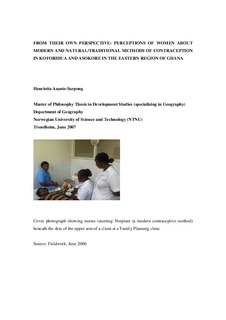| dc.contributor.author | Ansante-Sarpong, Henrietta | nb_NO |
| dc.date.accessioned | 2014-12-19T14:25:32Z | |
| dc.date.available | 2014-12-19T14:25:32Z | |
| dc.date.created | 2007-06-25 | nb_NO |
| dc.date.issued | 2007 | nb_NO |
| dc.identifier | 122455 | nb_NO |
| dc.identifier.uri | http://hdl.handle.net/11250/265221 | |
| dc.description.abstract | Population growth or increase comes about because of the interplay of the three main demographic variables namely fertility, mortality and migration. This growth can be high, low or stable and all these have implications for a country’s socio-economic development and the standard of living of the people. With a current total fertility rate of 4.4, Ghana is still faced with the challenge of a high population growth rate. (Ghana Statistical Service et al 2004a) Since the 1960’s the government of Ghana and other stakeholders have tried to come up with programs and campaigns to address the population question. This included the introduction of Family Planning and contraception into the country as a measure to reduce fertility rates and hence population growth. As at 2003 however Ghana’s contraceptive prevalence rate was 25.2%, lower than that of many other countries in sub-Saharan Africa (Ghana Statistical Service et al 2004a)
The study therefore sought to know the perceptions and assessments women have about contraceptives and how that is contributing to the low usage of contraception in the country. Women formed the majority of the respondents of this study because they are the primary users of contraceptives. 20 married women (10 each) were selected from an urban and a peri-urban area in the Eastern Region of Ghana. Five of the women chosen were between the ages of 25-30 and the remaining five 40-45 years in each of the study areas. The region was chosen because it has a Contraceptive Prevalence Rate of 27% which is closer to the national average. Four spouses of the women were interviewed as well as family planning service providers in four pharmacies and a family planning clinic. The study was basically qualitative in nature and structured and semi-structured interview guides were used for the interviews. The structuration theory and the feminists’ approaches of Gender and Development (GAD) and Women Culture and Development (WCD) were used in explaining the findings of the study.
The findings of the study revealed that most of the women had positive perceptions about both the natural and modern methods of contraception. They indicated how beneficial contraceptives are in controlling fertility rates. Many women especially those in the periurban area were however worried about the side effects of some of the modern methods. The study also revealed that there were more women using natural contraceptive methods in the urban area than in the peri-urban area. The main factors contributing to this is less education on the natural methods and the inability of women with relatively lower socioeconomic status to negotiate with their husbands in order to adopt the methods effectively. Education was seen as the major factor to be considered in improving contraceptive usage in the country. It is most likely that contraceptive usage will improve if men are actively involved in family planning.
Some limitations of the study were that, the study made use of a small sample size because of its qualitative nature. A quantitative study with a large sample size will help for generalizations to be made. It would also have been interesting for one to investigate the topic along a rural/urban angel than the urban/peri-urban angel used in this study. Further studies could also include more males in the sample of the study. | nb_NO |
| dc.language | eng | nb_NO |
| dc.publisher | Geografisk institutt | nb_NO |
| dc.subject | Master of Philosophy in Development Studies, specialising in Geography | en_GB |
| dc.title | From their own perspective: perceptions of women about modern and natural/traditional methods of contraception in Koforidua and Asokore in the eastern region of Ghana | nb_NO |
| dc.type | Master thesis | nb_NO |
| dc.contributor.department | Norges teknisk-naturvitenskapelige universitet, Fakultet for samfunnsvitenskap og teknologiledelse, Geografisk institutt | nb_NO |
